It’s incredibly hot outside, and people need to take a break from all that sun and fun. What better way to do so than with some video games? There’s bound to be a few titles in your library that you haven’t really checked out yet, and this month’s roundtable might just give you the push you need to give ’em a spin! Besides, outside is overrated anyway.
Rocket Knight Adventures By Ken Horowitz
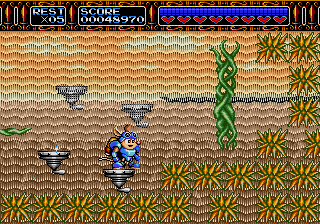 Let me say this outright: I think pigs make excellent bad guys. Better than zombies or Nazis, pigs are just tailor-made for evil. Mind you, this is not meant as an insult to the little porkers. Far from it! It’s actually a compliment to their range in talents. What other creature could both produce scrumptious bacon and be such perfect villains? None, I say! From Ganon in the Legend of Zelda to corrupt porcine cops in Duke Nukem 3D, they represent tough, no-nonsense foes that only a hero with an indomitable will can overcome (that last part may actually just refer to how they always make me think of bacon, but who can tell?).
Let me say this outright: I think pigs make excellent bad guys. Better than zombies or Nazis, pigs are just tailor-made for evil. Mind you, this is not meant as an insult to the little porkers. Far from it! It’s actually a compliment to their range in talents. What other creature could both produce scrumptious bacon and be such perfect villains? None, I say! From Ganon in the Legend of Zelda to corrupt porcine cops in Duke Nukem 3D, they represent tough, no-nonsense foes that only a hero with an indomitable will can overcome (that last part may actually just refer to how they always make me think of bacon, but who can tell?).
To me, this is what gives RKA a lot of its charm. In a game with a possum hero out to save a steampunk kingdom, why not pigs? For some reason, they seem to fit right in with everything else, and by everything else I mean incredible visuals, a memorable soundtrack, excellent level design, and some extremely polished controls. Konami’s first title on Sega’s 16-bit monster is by far it’s best, and it is one of those games fans of the console can point out as having that uniquely Genesis feel. It was a game that made SNES owners nod their head in respect to the mighty Genesis and one that should be in every game library.
And I still think that pigs had a lot to do with that.
FIFA ’98: Road to World Cup By Sebastian Sponsel
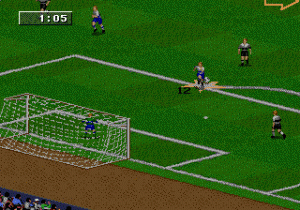 I still remember when I got FIFA International Soccer the month it was released. I distictly recall thinking that this game was just plain awesome. The controls. The atmosphere. The level of realism. All of this was brand new, gripping, and top-notch. IT was simply THE SHIT. Many a schoolyard friend cast aside his Amiga copy of Sensible Soccer in favor of this ultra-realistic simulation of our favorite sport, with it’s 16 MEG and four-way play! Some of my teammates from our little village’s youth soccer team would swing by my place regularly for weeks on end, and we’d have big world championship tournaments as well as team matches. Thanks to my four-player-adapter, these events could get a big crowded as well as loud. I remember my grandpa scolding us young’uns several times because of that. And even though I usually didn’t get along with some of the guys coming over just for the FIFA sessions, playing the game with that many people just felt great… at least for a while. Then FIFA ’95 came out the year after, and it was even better. Another teammate had gotten a Mega Drive by then, and he got the game as well, so our lengthy, rowdy console sessions moved to his place (a move my grandfather gladly supported). Then came FIFA ’96, which I got again, and it played better still.
I still remember when I got FIFA International Soccer the month it was released. I distictly recall thinking that this game was just plain awesome. The controls. The atmosphere. The level of realism. All of this was brand new, gripping, and top-notch. IT was simply THE SHIT. Many a schoolyard friend cast aside his Amiga copy of Sensible Soccer in favor of this ultra-realistic simulation of our favorite sport, with it’s 16 MEG and four-way play! Some of my teammates from our little village’s youth soccer team would swing by my place regularly for weeks on end, and we’d have big world championship tournaments as well as team matches. Thanks to my four-player-adapter, these events could get a big crowded as well as loud. I remember my grandpa scolding us young’uns several times because of that. And even though I usually didn’t get along with some of the guys coming over just for the FIFA sessions, playing the game with that many people just felt great… at least for a while. Then FIFA ’95 came out the year after, and it was even better. Another teammate had gotten a Mega Drive by then, and he got the game as well, so our lengthy, rowdy console sessions moved to his place (a move my grandfather gladly supported). Then came FIFA ’96, which I got again, and it played better still.
And now? Now, every time I play any of the FIFA games, I can’t help but feel that the Mega Drive games have aged horribly over the years. Unlike the old NHL series, which still feels action-packed and tight, FIFA just feels sluggish, drab and lacking in position. There’s no free control over your player, you can just move in eight fixed directions. Worse, after FIFA reached it’s apex on the Mega Drive with the ’96 edition, the two games released after that just seemd to have gotten worse. This month I popped in FIFA ’98 again… and it was so dull! The controls feel inprecise, everything moves so slowly, and I still haven’t found a reliable way of scoring… everything just seems to happen at random. And since I don’t harbor that many nostaligic memories for this particular entry, I have to admit: I even like the very first FIFA game better than this one. But only just. If I want Mega Drive soccer, I’ll stick to Sensible International Soccer or ISS Deluxe nowadays, thank you very much.
Eliminate Down By The Coop
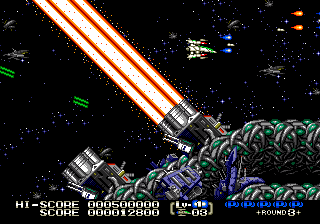 Ever buy a game, and find yourself glad you got it years later? Not because you hated it at first, or because you just set it aside and didn’t play it for a long time, only to discover that it’s something you wished you’d started playing long ago. I mean, you buy it, play it, enjoy it, and then somewhere down the road, you see how much it’s going for cash-wise. Well, such is the case with this little game.
Ever buy a game, and find yourself glad you got it years later? Not because you hated it at first, or because you just set it aside and didn’t play it for a long time, only to discover that it’s something you wished you’d started playing long ago. I mean, you buy it, play it, enjoy it, and then somewhere down the road, you see how much it’s going for cash-wise. Well, such is the case with this little game.
Eliminate Down’s not exactly the best shmup on the system. Oh, it’s good to be sure, but it’s not Thunder Force IV level of good. Even so, the graphics are well done, with some nice parallax and good color use in places. The levels and bosses are nice with some vertical movement on some stages to help break things up a little. It’s got a pretty good challenge to it as well, with a final boss that still kicks my butt to this day. On the flip side, it doesn’t really do much in terms of innovative gameplay, and the music isn’t the best, thanks to some instruments that can get pretty grating at times. But overall, it’s an enjoyable, solid shmup for our old 16-bitter. The thing is… well… holy HELL has the price gone up for it!
I have the Korean version, which was published by Samsung back in the day. It’s the same game, just with a different packaging and some artwork changes (the manual has this odd texture to it… it’s weird). But this game used to go for about $100 for the Japanese version, and less than that for the Korean version (I got mine for about $50). But now? A browsing of ebay shows the Japanese version of this game fetching well over $700 for a used copy. Read that sentence again, and then meet me at the next paragraph.
Crazy stuff, huh? As I said, it’s a good game, but not that good. That’s a higher asking price than Radiant Silvergun, Gley Lancer and M.U.S.H.A.… combined. And all of those are better shmups. I’m not sure when that level of rare factor kicked in, or when people got more money than common sense and drove the “willing to pay” price up that high, but it happened. I can’t even begin to fathom blowing that much cash on a single Genesis game… or a game in general for that matter. But, if you have the copious amounts of burnable cash needed, it’s a good entry for the Genesis shmup library. There’s no lock out, so you can just pop it in and play… and you better do that A LOT to get your money’s worth out of it.
Phantasy Star IV By Joseph C.
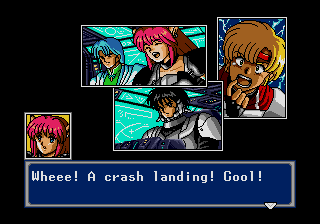 This month I’ve been in (what for me is) the rare mood for JRPGs. I just grabbed Tales of Versperia for Xbox 360, started playing the PlayStation classic Xenogears and have continued on and off with the DS action RPG Phantasy Star Zero. Naturally the latter title had my thoughts dwelling on the first Phantasy Star I played which happened to be the fourth title.
This month I’ve been in (what for me is) the rare mood for JRPGs. I just grabbed Tales of Versperia for Xbox 360, started playing the PlayStation classic Xenogears and have continued on and off with the DS action RPG Phantasy Star Zero. Naturally the latter title had my thoughts dwelling on the first Phantasy Star I played which happened to be the fourth title.
I remember first seeing a review for Phantasy Star IV in Australia’s Hyper Magazine (which is amazingly still published). It was one of the last reviews for Mega Drive that I remember them publishing and despite having no experience with previous titles, I really wanted it. I finally found a copy for around $10 about two years later at a flea market. It was boxed but had no instruction manual. As you can imagine, I was really pleased with my find though and jumped straight into it.
If I don’t include action-RPGs, this was the first JRPG I ever played. I got about halfway through the game before getting stuck on the boss in the Air Castle. As it was my first turn-based JRPG, it never occurred to me to spend time grinding levels or to employ any strategy past attack and heal. Not having beaten it nagged at me though and I ended up going back to it again a few years later. By this stage I had far more experience with RPGs and I got through to the end relatively easily. This time having employed the spell combination system effectively along with spending plenty of time grinding. It had one of the best endings in a game ever and I only regretted not having begun the journey from the first title.
Looking back on the game now, it is still probably my favourite JRPG. In fact, the only gamse that have come close for me are Chrono Trigger, and Xenogears (if the first few hours are anything to go by). To be fair, there are still plenty I haven’t played though. Considering these titles, it is a shame that the Phantasy Star series has changed so fundamentally from its roots. Even though the Phantasy Star IV ended the original series perfectly, I’d still love to see a Phantasy Star V one day. For now, I’ve got IV to enjoy again and the original three still waiting to be played.
Ishido: Way of the Stones By Goldenband
When we evaluate whether a game is “good” or “bad”, do we use the standards of the present day, or of the time when it was released? Is it enough when a game provides an hour or two of genuine entertainment, even if it could be better or deeper? Should economics affect our judgment? That is, if a game originally cost $99.99 (like Virtua Racing), should we judge it by a different standard than a game that cost $19.99? What if we ourselves only paid five dollars on the used market, and feel like we got our money’s worth — should we still put ourselves in the shoes of a kid who paid MSRP on Day One?
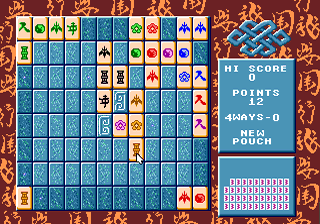 Such are the questions that go through my mind when playing Ishido: The Way of Stones, which received an abysmally negative review on Sega-16 some years back. Now, that reviewer didn’t enjoy the basic gameplay of Ishido one bit, so fair enough. In my world, fun is an absolute value that trumps every other consideration — as long as you’re canny enough to realize when the problem is you, and not the game or the genre. (I don’t like most modern FPS titles, but that reflects my own tastes and so I recuse myself from the discussion; give me a game like Onslaught or Andre Agassi Tennis, though, and I feel well-qualified to pass stern judgment.)
Such are the questions that go through my mind when playing Ishido: The Way of Stones, which received an abysmally negative review on Sega-16 some years back. Now, that reviewer didn’t enjoy the basic gameplay of Ishido one bit, so fair enough. In my world, fun is an absolute value that trumps every other consideration — as long as you’re canny enough to realize when the problem is you, and not the game or the genre. (I don’t like most modern FPS titles, but that reflects my own tastes and so I recuse myself from the discussion; give me a game like Onslaught or Andre Agassi Tennis, though, and I feel well-qualified to pass stern judgment.)
My copy of Ishido is complete, and I paid ten or twelve dollars for it. It even has the little faux-folkloric booklet that encouraged many to believe the game had roots in ancient Asian traditions (which it doesn’t). Perhaps the publishers included this extra bit of frippery to distract from the thinness of a release that has one of the smallest ROMs ever released on the Genesis, and offers nothing more than a single gameplay mode, variously re-skinned. And of course, it won’t even run on a Genesis with TMSS.
Even so, when I’ve gone to Ishido in search of 15 minutes’ worth of chilled-out, low-commitment puzzlecraft, it hasn’t yet disappointed me. Each time I fire it up, I gain a slightly better grasp of the game’s tricky dynamics, and find myself able to plan a bit further ahead. In my most recent session, I managed to empty my pouch of stones for the first time. This is the closest you can come to “beating” Ishido, but the challenge of getting more four-way matches remains. (The game implies you can get at least twelve in a game; I’ve only gotten one.)
Could Ishido be more than it is? Of course, and the lack of a decent soundtrack is especially disappointing. But unlike so many of the Genesis’s weakest titles (and more than a few of its “better” titles), this is one I can actually see myself wanting to replay again and again, if only on occasion. In other words, I don’t find myself needing to say whether Ishido is “good” or “bad;” I simply enjoy it for what it is.
Metal Head By Frank Villone
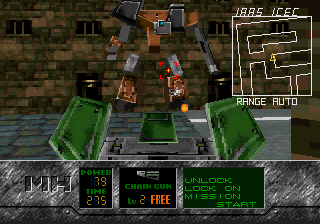 I found Metal Head in the wild a couple years ago, and I was so disappointed! The mech walks so slowly, with such a choppy frame-rate! After moving to an awesome studio apartment, I found the frame-rate less disturbing on a TV that is viewed across a large room, instead of up-close. Also, the dash button became familiar, and the choppiness somehow stops bothering my eyes, when cruising at top speed.
I found Metal Head in the wild a couple years ago, and I was so disappointed! The mech walks so slowly, with such a choppy frame-rate! After moving to an awesome studio apartment, I found the frame-rate less disturbing on a TV that is viewed across a large room, instead of up-close. Also, the dash button became familiar, and the choppiness somehow stops bothering my eyes, when cruising at top speed.
Most missions are easy and fast after some practice, so the gameplay becomes just breezing through the streets and shooting at robots! Different kinds of missions prevent it from being tedious and extend the replay value, although they can seem random: Finding and blowing up a trailer full of explosives, or tracking down and killing a certain mech, for example.
The team’s art style should be changed in the options menu. The default looks ridiculous: Photos that are animated badly, while the alternate hand-drawn characters look good, and they have the same clear voices. The third choice is to use a code for anime-style characters, but then the voices are replaced by clicking sounds. The rock music is generic and forgettable, plus the sound effects are very quiet, so muting the TV is best.
Stages include cities with nuclear yellow skies, night-time city streets full of glowing neon signs, and the last stages even resemble a giant haunted mansion! I wish the environments could be damaged by weapon fire, but they do at least show a tiny bit of the 32x’s potential to create detailed, 3D texture-mapped worlds!

Recent Comments